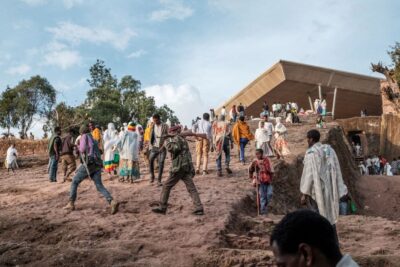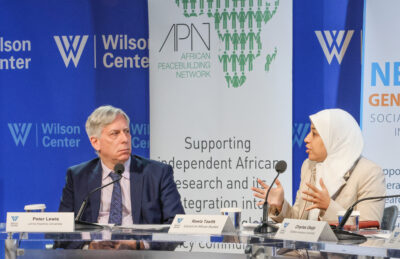In many parts of Europe and beyond, the pandemic experience in the spring of 2020 was characterized notably less by the spread of infection itself (as in the case of northern Italy, for example) than by the interruption of everyday life due to the lockdown. While, for many, the surreal situation may have been difficult to grasp, it offered room for very different interpretations and perceptions—depending on social, economic, and cultural capacities and conditions.
Although the drastic lockdown measures widely imposed throughout Europe starting from mid-March 2020 were considered by most Europeans to be appropriate and necessary,1Damien Bol et al., “The Effect of Covid‐19 Lockdowns on Political Support: Some Good News for Democracy?” European Journal of Political Research, May 19, 2020. they have been described—in public debates by experts and in quick-response studies2Katja Schulze et al., “Die SARS-CoV-2-Pandemie aus Sicht der Bevölkerung. Ergebnisse einer Bevölkerungsbefragung” (working paper, Katastrophenforschungsstelle, Freie Universität Berlin, 2020). to assess the measures—as both a radical step and catastrophic experience with hitherto unforeseeable secondary consequences. These ranged from more general fears about the proportionality of the means used, especially with regard to the curtailment of basic rights, to fears of high psychological consequences—particularly for “vulnerable groups,” such as the elderly or mentally ill—to an increase in domestic violence, rise in suicides, and unforeseeable consequences for children and young people. Some German respondents—in surveys, for instance—even expressed “fear of death” and severe experiences of retraumatization due to the restrictions on individual freedom of movement.3Schulze et al., “Die SARS-CoV-2-Pandemie aus Sicht der Bevölkerung.”
Besides these fears and negative consequences, this period was also described and felt by many people as a utopian situation. Here we begin to analyze these positive descriptions and experiences. For a more detailed understanding, we will refer to the literature on the emergence of new communities in disasters and on “disaster utopia.” Then, we will briefly present literature on these phenomena and their significance that is relevant to our argument and outline different manifestations of the phenomena specifically within the lockdown phase of the pandemic. These manifestations are then discussed with regard to much-discussed findings of disaster research.
Finding community in the pandemic
“In contrast to the stories of violence and antisocial behavior widely reported postdisaster in the media, in most cases, people show solidarity with one another and often develop a special sense of community in the face of shared affliction by ‘the dangers and privations imposed by the disaster agent.’”Since its beginnings, social science disaster research has shown that disasters are not events with exclusively negative consequences, such as deaths, injuries, human suffering, and material losses. Positive and utopian experiences can also arise in and after disasters. An aspect of disasters described in the literature is the unexpected emergence of new social communities, even across class and/or racial boundaries, the “breakdown of racial and minority group barriers, and the acceptance of minority group members into new social roles.”4Charles E. Fritz, “Disaster and Mental Health: Therapeutic Principles Drawn from Disaster Studies” (Newark, DE: University of Delaware, 1996), 33. In contrast to the stories of violence and antisocial behavior widely reported postdisaster in the media, in most cases, people show solidarity with one another and often develop a special sense of community in the face of shared affliction by “the dangers and privations imposed by the disaster agent.”5Fritz, “Disaster and Mental Health,” 29. Robert I. Kutak observed a “democracy of distress” during the Louisville flood of 1937, in which previously unknown commonalities between affected persons suddenly became apparent.6“The Sociology of Crises: The Louisville Flood of 1937,” Social Forces 17, no. 1 (1938): 72. Susanna Hoffman speaks of a “sense of unity” in the context of the 1991 Oakland fire storm.7Susanna M. Hoffman, “The Worst of Times, the Best of Times: Toward a Model of Cultural Response to Disaster,” in The Angry Earth: Disasters in Anthropological Perspective, eds. Anthony Oliver-Smith, Susanna M. Hoffman (London: Routledge, 1999), 134–155. Other terms used in this context are extraordinary community,8 New York: Penguin, 2009More Info → communitas,9
New York: Penguin, 2009More Info → communitas,9 London: Palgrave Macmillan, 2015More Info → community of sufferers,10Charles E. Fritz, “Disaster,” in Contemporary Social Problems: An Introduction to the Sociology of Deviant Behavior and Social Disorganization, eds. Robert K. Merton and Robert A. Nisbet (New York: Harcourt, Brace. & World, 1961), 651–694. accidental community,11Liisa H. Malkki, “News and Culture: Transitory Phenomena and the Fieldwork Tradition,” in Anthropological Locations: Boundaries and Grounds of a Field Science, eds. Akhil Gupta and James Ferguson (Oakland, CA: University of California Press, 1997), 86–101. or postdisaster solidarity.12Anthony Oliver-Smith, “The Brotherhood of Pain. Theoretical and Applied Perspectives on Post-disaster Solidarity,” in The Angry Earth: Disasters in Anthropological Perspective, eds. Anthony Oliver-Smith, Susanna M. Hoffman (London: Routledge, 1999), 156–172.
London: Palgrave Macmillan, 2015More Info → community of sufferers,10Charles E. Fritz, “Disaster,” in Contemporary Social Problems: An Introduction to the Sociology of Deviant Behavior and Social Disorganization, eds. Robert K. Merton and Robert A. Nisbet (New York: Harcourt, Brace. & World, 1961), 651–694. accidental community,11Liisa H. Malkki, “News and Culture: Transitory Phenomena and the Fieldwork Tradition,” in Anthropological Locations: Boundaries and Grounds of a Field Science, eds. Akhil Gupta and James Ferguson (Oakland, CA: University of California Press, 1997), 86–101. or postdisaster solidarity.12Anthony Oliver-Smith, “The Brotherhood of Pain. Theoretical and Applied Perspectives on Post-disaster Solidarity,” in The Angry Earth: Disasters in Anthropological Perspective, eds. Anthony Oliver-Smith, Susanna M. Hoffman (London: Routledge, 1999), 156–172.
At the local level in the lockdown, new social communities emerged, for example, with younger people helping older people with their shopping so that they would not expose themselves unnecessarily to the risk of infection. Beyond physical borders, the exchange via digital media enabled new and other forms of community building, both within the immediate family and circles of friends, but also through virtual exchange forums, streamed cultural events or concerts. Entire neighborhoods created new communities of solidarity as people met on balconies every evening to sing, make music, or applaud medical staff.
These forms of special social cohesion under extremely adverse conditions represent important social science findings in disaster research insofar as they illustrate that disasters—understood here in the sense of the disintegration of everyday social structures—do not simply destroy communities. As genuine social processes, they also have diverse productive social effects. Disasters are therefore always also a reconfiguration of social order, which can be experienced by affected actors in very different ways.
“Whereas the local communities that arise out of disasters from natural hazards in most cases necessitate immediate physical proximity on the ground and may later survive virtually, the communities formed out of the pandemic were restricted to minimal physical proximity or were entirely virtual from the outset.”Despite all the similarities to communitas with its postdisaster solidarity, as found in scientific discourse, the context of the pandemic is distinct in a few important ways. For example, the actors described in the aforementioned instances are not primarily people affected by the virus itself, or even survivors confronted with common survival problems, but rather people who were “only” affected by the lockdown measures, i.e., at most secondarily. Whereas the local communities that arise out of disasters from natural hazards in most cases necessitate immediate physical proximity on the ground and may later survive virtually, the communities formed out of the pandemic were restricted to minimal physical proximity or were entirely virtual from the outset.
Although new forms of community were also created, interactions and community building often took place in more or less socially established forms—in neighborhoods, based on prior existing common interests and on the basis of belonging to certain socioeconomic groups. Accordingly, it can be assumed that the communities created by the pandemic only included certain groups of people, were already based on some kind of pre-established social networks and resources, and were thus selective and, to some extent, exclusionary: The sick, those who had lost relatives or friends, and marginalized groups were often not among them. This is by no means intended to diminish these interactions and newly formed communities, but it does seem significant for the classification.
The disruption of everyday practices as source of disaster utopian moments
“This otherwise unfamiliar freedom without external control and social structuring can and will be filled by the people affected by the disaster with their own rules and ideas, a step they need to take in order to cope with it.”As disaster research has illustrated, the emergence of new communities in disaster through the dissolution of routinized social order is often also linked to utopian experiences. “Catastrophe comes from the Greek kata, or down, and streiphen, or turning over. It means an upset of what is expected and was originally used to mean a plot twist. To emerge into the unexpected is not always terrible, though these words have evolved to imply ill fortune,” Rebecca Solnit writes in A Paradise Built in Hell.13Solnit, A Paradise Built in Hell, 10. “Disasters provide an extraordinary window into social desire and possibility, and what manifests there matters elsewhere, in ordinary times and in other extraordinary times,” she writes.14Solnit, A Paradise Built in Hell, 6. The catastrophic experience can also be viewed in terms of the liminality Victor W. Turner described for nondisaster rites of passage as early as 1964, i.e., the state of ambiguity and disorientation (“to ‘be in another place’”), in which the rules—and thus also the limitations—of everyday life are suspended.15Victor W. Turner, “Betwixt and Between: The Liminal Period in Rites de Passage,” in Symposium on New Approaches to the Study of Religion. Proceedings of the 1964 Annual Spring Meeting of the American Ethnological Association, ed. June Helm (Seattle: 1964), 4–20. This otherwise unfamiliar freedom without external control and social structuring can and will be filled by the people affected by the disaster with their own rules and ideas, a step they need to take in order to cope with it. “If paradise now arises in hell, it’s because in the suspension of the usual order and the failure of most systems, we are free to live and act another way.”16Solnit, A Paradise Built in Hell, 10. The pioneer of US disaster research Charles E. Fritz calls this phenomenon a disaster utopia, which “provides an unstructured social situation that enables persons and groups to perceive the possibility of introducing desired innovations into the social system […] People see the opportunity of realizing certain wishes which remain latent and unrealizable under the old system […] They see the possibility of wiping out old inequities and injustices.”17Fritz, “Disaster,” 685.
The disruption of social order through the lockdown in the early phase of the pandemic surprisingly evoked very similar descriptions and feelings to those in the aforementioned classical disaster-sociological analyses, such as in the case of the destruction of the physical environment through natural hazards or infrastructure failures such as blackouts. Suddenly, everyday life no longer functioned as usual, routines had to be questioned and the situation gave way to creative freedom: “The flow of everyday life is disrupted, so that our habits, routines, and coping skills must now deal with it within the bounds of their inherent flexibility: The Covid-19 emergency has highlighted a number of consequences related to our human actions, and the disruption thereof.” The lockdown phase was described as deceleration of the world, “[t]here is a strange ‘taste’ of the silence, of new ‘free’ time, and sense of distances and space: Everything now looked almost surreal and distant.” “This is the resonance mode: It is only in this mode that something new and unexpected can arise.” In terms of family and partnership, a “return to the essentials” was welcomed, as well as “finally” having space for the completion of postponed matters or simply having “time to read.”18Schulze et al., “Die SARS-CoV-2-Pandemie aus Sicht der Bevölkerung.” There were also hopes for long-term positive effects on the environment and the impact of climate change. Thus, the situation was also interpreted as a “test for society and the system,” a “challenge for humanity,” in which there is also an opportunity for a major rethink, which is hopefully also linked to a social transformation that will have an impact beyond the crisis.
Thus, in terms of utopian experience, as well as the emergence of new communities, parallels to catastrophic events become apparent in the lockdown: the disruption of the rules and routines of everyday life, thrilling, sometimes even joyful experiences, but also the hope that a better world may emerge from the disaster. Here, too, these utopian experiences and hopes were certainly by no means possible for everyone. Discovering unknown freedoms in the lockdown requires also being free of great loss, fear, or other negative experiences during that period—in other words, a certain minimum of physical and social security as well as mental well-being is essential.
Dissolution of the utopian moments
“At present, it remains completely unclear what human losses will be tied to the pandemic and what economic slumps will follow.”The utopian moments described above thus proved to be presuppositional and socially exclusive. For those who were able to experience them, however, they seem at the same time to be tied to a certain period of the pandemic’s development. But as lockdown measures were successively lifted during the summer, not only did the dystopian moments—such as the huge loss of jobs and income, increase in physical abuse, or large deficits in education—become visible, but the utopian moments for those who experienced them also increasingly faded away. Both the perpetual catastrophic consequences of the pandemic and everyday life with its rules, structures, and limitations have returned to the collective consciousness: Disputes about the appropriate infection protection measures, struggles for compensation payments, as well as outbidding in the competition to reopen, and discussions regarding new lockdowns have engulfed the utopian experiences and hopes. Fritz observed similar effects in other disasters decades ago: “The community of sufferers […] wanes and begins to disintegrate, as people return to normal pursuits and the process of social differentiation begins to manifest itself.”19Fritz, “Disaster and Mental Health,” 30. At the same time, it also became evident that the lockdown by no means eliminated social inequalities—rather, the utopian experience was in most cases only made possible by privileges, social status, and socioeconomic resources. At times, the lockdown exacerbated inequalities. More than a million people have already died. Infections are still on the rise. Unemployment figures have risen considerably. At present, it remains completely unclear what human losses will be tied to the pandemic and what economic slumps will follow.
Beyond disaster utopian moments in the current pandemic
Out of this discussion, various questions arise about the relationship between disaster utopian moments and dystopia in the pandemic, but also more generally about the place and significance of utopias in disasters. For example, the pandemic raises questions that need to be examined empirically in the future. It remains to be analyzed how these developments will change the disaster utopian moments in hindsight, whether there will be a romanticized nostalgia of this first phase of the pandemic, as in other disasters, or whether these experiences will be taken over by completely dreadful memories and narratives. In addition, conceptual questions arise for a more detailed localization of the disaster utopian moments of the pandemic in comparison to other disasters, such as those caused by natural hazards, where political measures to contain and limit damage have a different significance in the public’s perception. While the pandemic has given way to the phenomenon of disaster utopian moments, as has been the case in other disasters, as a global event it also has the potential to provide entirely new and instructive insights into this area of social science disaster research.
Banner image: Byronv2/Flickr.













